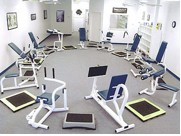Physical Training for Law Enforcement Combat
By Cpl. Michael Johnson, CPT, RKC
July 17, 2008 11:53 AM

If you examine the strength & conditioning training programs utilized by professional boxers and mixed martial artists while preparing for a fight you'll note the use of a variety of training strategies. Most fighters incorporate some form of weight lifting for strength training and running or skipping rope for their aerobic training. However, any experienced fighter understands that the metabolic demands of a fight are very different from the demands of pulling a heavy triple deadlift or going for a 3 mile run. There's an in between form of conditioning that marries the anaerobic and aerobic systems that a fighter needs for success; this form of conditioning is known as Circuit Interval Training.
 This is not a fighter's circuit training
This is not a fighter's circuit trainingDuring Circuit Interval Training fighters will set up a series of exercise stations generally composed of weights, medicine balls, heavy bags, body weight drills, and partner drills. They will move from one station to the next without rest for a set period of time, usually the length of a 3 or 5 minute round. This is followed by a 30-60 second rest period and then repeated for 3-12 rounds, depending on the expected duration of the bout. This form of conditioning teaches a fighter fatigue management and breath control, while building strength endurance and mental toughness.
The reward of elite level Interval Circuit TrainingSo you may be saying to yourself "I have no intent on being a cage fighter; what does this have to do with being a police officer?" There is a strong likelihood over the course of your career that you will have to take a resisting subject into custody and/or defend yourself from an aggressive assailant determined not to go to jail. The F.B.I. Uniform Crime Report showed 58,634 police officers were assaulted and 48 feloniously killed in the line of duty during 2006. Unfortunately for us there is no referee to step in on our behalf if things are not going our way, we have to fight under rules that our suspects don't have to follow, we don't know in advance who, where, or when we will have to fight, and a loss on our records could mean not going home at the end of shift. So keeping your defensive tactics skills sharp and being in top physical condition is imperative; Interval Circuit Training is a perfect way to improve the latter.
Typically it can take 3-10 minutes for a back-up officer to reach you depending on the beat size you work. So you should be prepared for the worst case scenario, the 10 minute fight. If you're new to training outside your comfort zone, and this type of training will definitely take you there, then start with the beginner program. This will get you physically ready for a 3-5 minute struggle. Start by setting a watch or timer for 3 minutes. Select one exercise from each group and perform them in circuit fashion. There are no predetermined rep or set schemes. Just perform one exercise as quickly as possible until fatigued and then go to the next. Keep repeating the sequence until time has expired. Rest 1-2 minutes and repeat the cycle for two more rounds. Gradually work up to five 3 minute rounds.
(Check with your physician before beginning any rigorous training program)
"Napoleon, we both know I'm training to be a cage fighter"Beginner Template: Three to Five 3 minute rounds (1 minute rest between rounds) Group A Group B Group C Group DPush-ups Pull-ups Body weight Squats Guard Sit-ups
Burpees Body Rows Kettlebell Swings Cable Rotations
Bar Dips Rubber Cable Rows Body weight Lunges Leg raises
Pace yourself in the beginning if you don't already have a fair aerobic or strength base. As your level of conditioning improves you will be able to perform longer sets at a faster pace for each 3 minute round. Once you can complete five 3 minute rounds move onto the Intermediate Template.
Intermediate Template: Three to Four 5 minute rounds (1-2 minutes rest between rounds)Group A Group B Medicine Ball Push-up Pull-ups
Ring Push-ups Body rows
See-Saw Press Renegade Row
Clean & Press Rope Climb
Group C Group D Wood chopper Lunges Russian Twist (6-20 lb medicine ball)
Dumbbell Squat & Press Heavy Bag Elbow Strikes
Kettlebell Clean & Jerk Hanging Knee-up
Tactical Lunges Slam Ball (15-20lb medicine ball)
The exercises are not set in stone. You may choose some of your own personal favorite drills to substitute for the ones I've listed. Just make sure they are exercises that require the effort and coordination of multiple muscle groups. Don't substitute Push-ups with Tricep extensions or Lunges for Machine Leg Curls. When the Intermediate Template becomes manageable it's time for the Advanced Template. This will prepare you for the 10 minute fight.
Advanced Template: Two to Three 10 minute rounds (3-5 minutes rest between rounds) Group A Group BExplosive alternating 1 arm push-up Kipping Pull-ups
Depth drop Push-ups Explosive T-Push-up Row
Dumbbell Squat & Press Double Kettlebell Cleans or Power Cleans
Wall Ball (15-20lb medicine ball) Double Kettelbell Snatch or Power Snatches
Group C Group D Jumping Squat (15-20lb medicine ball) Full Contact Twists
Explosive Lunge twists (12-18lb medicine ball) Hot Potato Russian twists
Kettlebell Burpees Half Get-ups
Kettlebell Snatches Alternating Hanging Leg raise
Note that most of these drills are explosive in nature, so stop and switch to the next drill when you notice a significant decrease in your speed. Again, these drills are not set in stone. If you have a heavy bag you can sub any of the Group A drills for heavy bag punches and any of the Group C drills for heavy bag kicking. Picking a heavy bag off the ground, shouldering it, doing a squat, slamming it back on the ground, and repeating is also an excellent drill. If you're not sure how to perform some of these drills try a Google Image search for pictures of the drills.
You can perform Interval Circuits two to three times a week or substitute them once or twice a week in place of your regular cardio or strength training work. You may also vary the number of rounds you perform in each workout to accommodate your schedule or individual recovery ability.
Keep in mind that no amount of physical training replaces the technical practice of your defensive tactics needed to give you the best chances of winning an altercation. However, Interval Circuit Training is an excellent means by which to improve your work capacity in order to outwork your suspect in combat. It doesn't require a lot of fancy or expensive equipment and it can be done at home or at the gym. In my agency 101 police officers were assaulted while on duty last year. That's more than 25% of our force. The question is not if a physical confrontation will occur on the job, but will you be prepared when it does.
About the author: Michael Johnson, CPT, RKC is a 10 year police veteran for a county agency in Maryland. Mike is currently assigned to his agencies police academy as a defensive tactics and P.T. instructor. Mike is also a certified G.R.A.P.L.E. Instructor under the Gracie's and a Purple Belt in Brazilian Jiu-Jitsu under Professor Pedro Sauer. Mike teaches BJJ at the Baltimore Martial Arts Academy in Ellicott City, Maryland. He can be contacted at Spoony02@verizon.net
Back